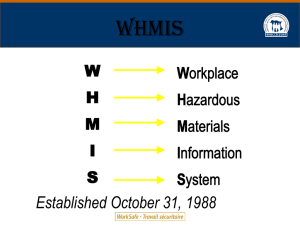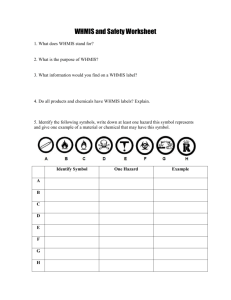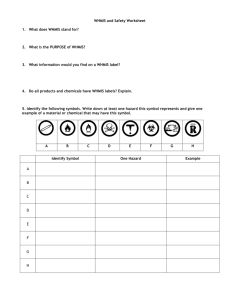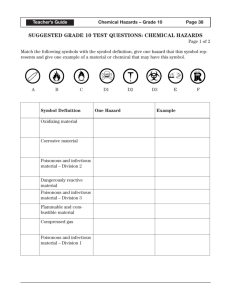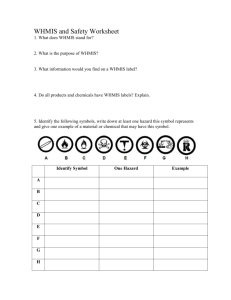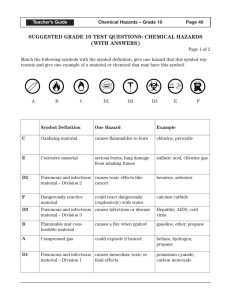whmis_powerpoint_for_gr._9
advertisement
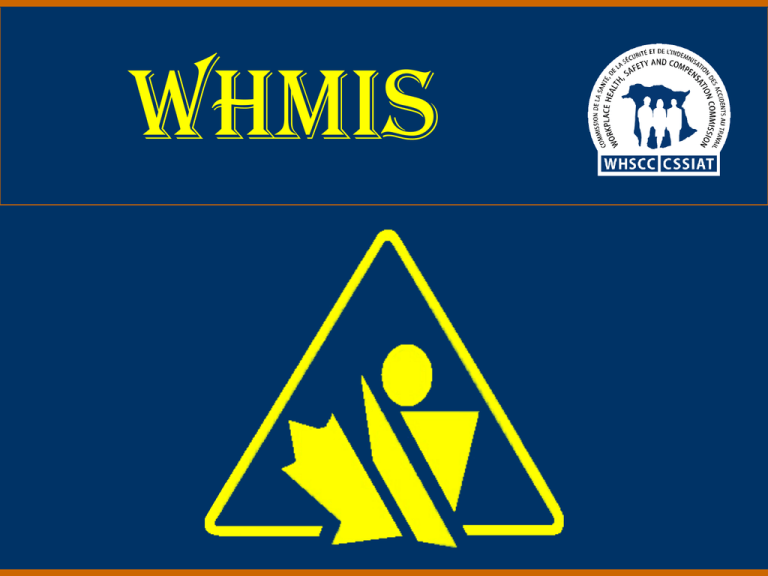
WHMIS WHSCC/Cssiat 2003 W Workplace H Hazardous M Materials I Information S System 2 Three Components of WHMIS 1. Labels on hazardous materials or their containers 2. MSDS or material safety data sheets which are technical bulletins providing more detailed information than the label 3. Worker education, providing instruction on hazards and safe work procedures 2003 8 In the Workplace, What is the “Key” to everyday WhMIS? HAZARD SYMBOLS! 2003 14 What Does This Symbol Mean? 1 of 2 2003 15 What Do We Know? 2 of 2 Compressed Gas (Class A): Poses an explosion danger because the gas is under pressure Container may explode if heated in a fire, or dropped 2003 16 What Does This Symbol Mean? 1 of 2 2003 17 What Do We Know? 2 of 2 Combustible and Flammable Material (Class B): Will burn and is therefore a potential fire hazard May burn at relatively low temperatures; flammable materials catch fire at lower temperatures than combustible materials May burst into flame spontaneously in air, or release a flammable gas on contact with water May cause a fire when exposed to heat, sparks, or flames, or as a result of friction 2003 18 What Does This Symbol mean? 1 of 2 2003 19 What Do We Know? 2 of 2 Oxidizing Material (Class C): Poses a fire and/or explosion risk in the presence of flammable or combustible material May react violently when it comes into contact with combustible materials such as fuels or wood May burn skin and eyes upon contact 2003 20 What Does This Symbol Mean? 1 of 2 2003 21 What Do We Know? 2 of 2 Poisonous and Infectious Material (Class D, Division 1): Is a potentially fatal poisonous substance May be fatal or cause permanent damage if it is inhaled or swallowed or if it enters the body through skin contact May burn eyes or skin upon contact 2003 22 What Does This Symbol Mean? 1 of 2 2003 23 What Do We Know? 2 of 2 Poisonous and Infectious Material: Other Toxic Effects (Class D, Division 2): Not immediately dangerous to health May cause death or permanent damage as a result of repeated exposure over time May be a sensitizer, which produces an allergy May cause cancer, birth defects, or sterility 2003 24 What Does This Symbol Mean? 1 of 2 2003 25 What Do We Know? 2 of 2 Poisonous and Infectious Material: Biohazardous, infectious material (Class D, Division 3): May cause a serious disease resulting in illness (AIDS, Hepatitis) or death Can also include tetanus protection 2003 26 What Does This Symbol Mean? 1 of 2 2003 27 What do We Know? 2 of 2 Corrosive Material (Class E): Causes severe eye and skin irritation upon contact Causes severe tissue damage with prolonged contact Often produces vapor or fumes that may be harmful if inhaled 2003 28 What Does This Symbol Mean? 1 of 2 2003 29 What Do We Know? 2 of 2 Dangerously Reactive Material (Class F): Is very unstable May react with water to release a toxic or flammable gas May explode as a result of shock, friction or an increase in temperature May explode if heated when in a closed container Undergoes vigorous polymerization 2003 30 Worker Education 1 of 2 Anyone working with or nearby controlled products must be trained in hazard information and procedures regarding: 1. Safe use 2. Storage 3. Handling 4. Disposal 5. Emergency procedures 2003 49 WHMIS Responsibilities Suppliers, employers and employees each have a role to play in making WHMIS work. 2003 53 Summary 1 of 2 WHMIS has three components: WHMIS is a hazard class driven system 2003 1. Labels 2. MSDS 3. Worker Education Compressed Gas Flammable Oxidizers Poisons Corrosives Reactive 59
